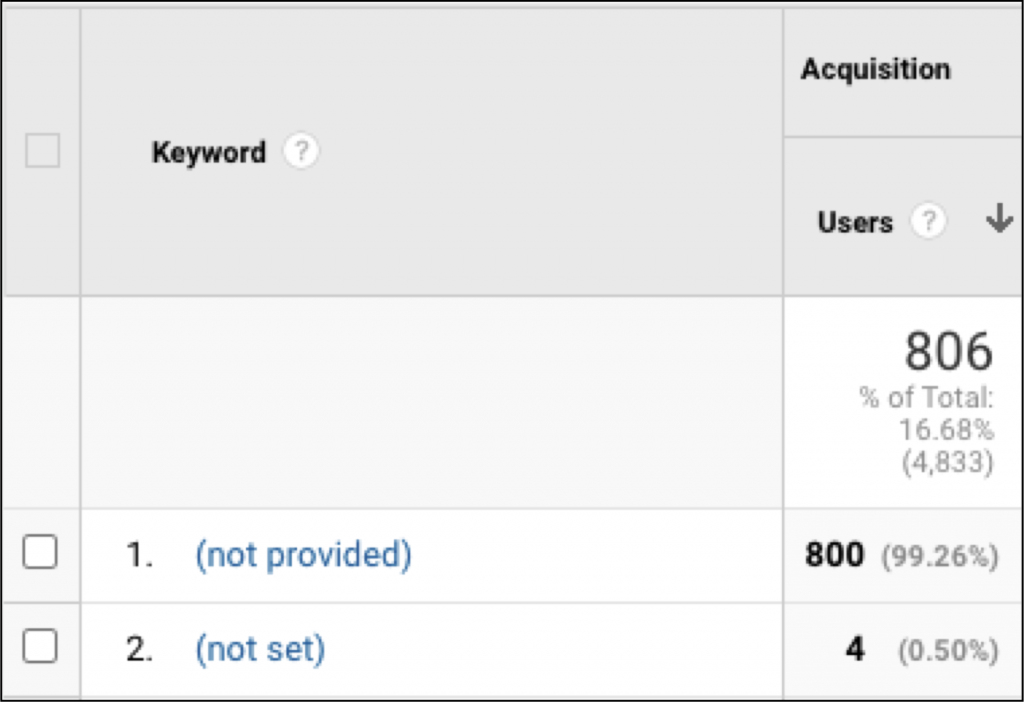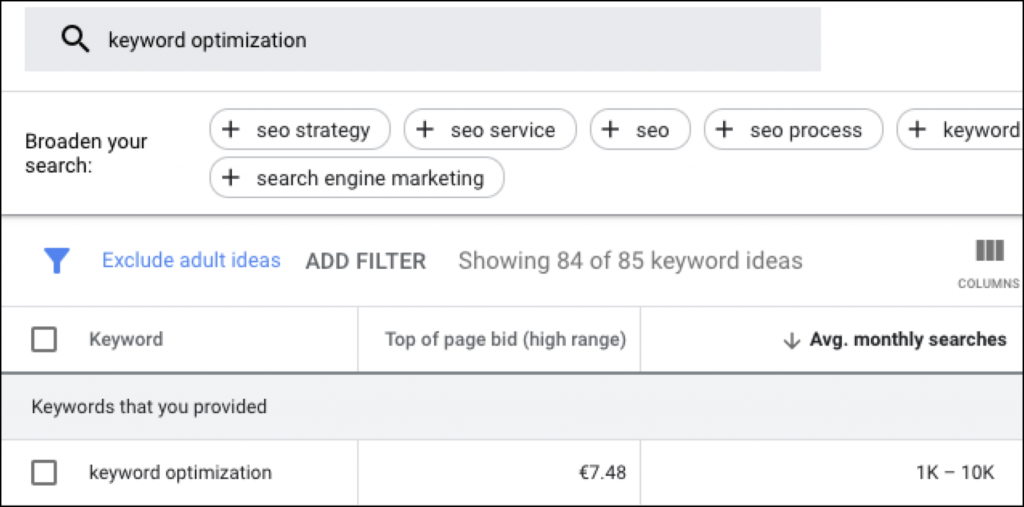Any new SEO and keyword optimization campaign has to start with keyword research, analysis, and keyword targeting.
It’s an unavoidable, value-adding step for SEO. Mess it up and you run the risk of executing an SEO strategy that fails to produce results.
However, optimizing keywords isn’t something you can get away with doing just at the outset of a search marketing campaign.
Continual tracking and updating is necessary to identify new keyword opportunities and to harness the traffic potential from various keyword verticals.
By continuously updating keywords based on performance your site traffic, leads and sales will grow, as your content will mirror user intent.
What is keyword optimization?

Keyword optimization is a three-step process that can help a business target qualified leads and drive them from search engine results to a website. It’s an important component for both paid and organic search strategies.
The three stages of keyword optimization are:
- Research
- Analysis
- Selection of the best keywords
Once you have moved methodically from keyword research to the analysis and keyword selection phase, you will have the necessary pillars of a robust keyword optimization strategy and will start to see the benefits in all future marketing campaigns.
Benefits of keyword optimization
Incorporating the right keywords helps improve website traffic and conversion rates.
Other benefits include helping you to:
Measure potential traffic flow
Keyword analysis can help you measure the size of your potential target market.
Understand user behavior
Keywords provide clues as to the needs of your target audience.
Write engaging content
Integrating optimized keywords into the content will help you to improve Serp rankings and subsequently drive more traffic to your website.
The right keywords can help you address your customer’s needs and pain points.
Despite all these benefits, though, you may be surprised how often SEO teams will do some keyword research at the start of a campaign and roll this forward. Big mistake.
SEO and Keyword optimization tactics
To select and concentrate your SEO initiatives on the right keywords you will need to follow a few crucial steps.
1. Choose the right keywords
Keyword optimization begins with using the right keywords. However, figuring out which keywords to use is a daunting task.
Why?
If you are new to SEO, you may or may not know that all organic keywords were once available in Google Analytics and on all other web analytics platforms. You can read all about it our beginner’s guide to ‘not provided.’
However, in 2011, Google gradually started removing these keywords.
In late 2011 through to the following year, a significant percentage of organic keyword visibility was stripped away.
It wasn’t long before (not provided) accounted for 99% of all search data, as seen below.

This came as a shock to everyone in the SEO community as the search report in GA was a beacon for organic keywords.
But, when there is a significant problem, solutions always arrive soon after.
People turned to Google Search Console, but there are limitations to GSC, as it only reveals a small portion of the keywords used.
Others use Keyword Hero, where keywords are reverse engineered with 83% certainty so you can once again track organic keyword conversions.
Using the best keyword optimization tools you can analyze and understand keywords and create an efficient SEO strategy.
2. Optimize your website
Apart from the technical tasks that you have to cover when optimizing your website, how do you optimize your website using the right keywords?
Where to use keyword-phrases on your webpages?
- Page title. The page title should have your keyword phrase. Google cares about the page title, and if your keyword phrase is there, it will send a signal to Google. Unless it sounds clunky, try to get your keyword in at the beginning of the title. Remember that only 48 characters will display in the Google search results.
- Page description. The page description or meta tags do not influence your position in the search results. However, it can influence clicks. The page description shows up as the two lines of text in Google’s search results. You need a good hook to get clicks.
- Body text. Place at least twice or three keywords in the body text. Try out variations of the same keyword to avoid keyword stuffing.
3. Content creation and optimization
Producing content that adds value for your target audience is dependant on keyword optimization.
You want to centre content around the keywords that people are searching for.
You can optimize your content in one of two ways:
You can first, compose a piece and then tailor it with keywords that are popular in your industry.
Or
You can do some keyword research first and then decide which keywords would make great content.
If you are using Google Ads Keyword Planner, you will see exactly how many monthly searches there are for a keyword.

NB the version available to you if you haven’t paid for at least one Google Ads campaign is limited and will only show the keyword volume as a range.

My advice is to run the minimum priced ad campaign, this can be $1, to unlock the full scope of Google Keyword Planner.
On-page keyword optimization
Now that you have a list of keywords you want to rank for and build content around, let’s take a look at on-page optimization.
Good keywords are worth nothing if we don’t incorporate them into our on-page strategy.
Our keyword research informs and guides almost every aspect of our on-page SEO strategy.
But exactly how do we incorporate our keywords into our content to rank higher and satisfy our visitors?
How keyword intent informs on-page SEO
Keyword intent and targeting is one of the 9 part SEO priority list.
In brief, imagine you want to optimize for the following keyword: ‘Tesla shares’.

The three primary classifications of search intent are ‘do’, ‘know’, and ‘go queries’.
For ‘do’ queries, the person wants to perform a specific action, like buy Tesla shares.
Do queries are at the bottom of the sales funnel.
In contrast, a ‘know’ query is an informational query, where the person wants to learn about a particular subject e.g. is Tesla stock overvalued?
Finally ‘go’ queries are usually brand queries, where a person is looking to go to a specific website or location. If someone is specifically searching for ‘Tesla merchandise’, serving them BMW, as a result, wouldn’t meet their needs.
A quick assessment of the top three Serp results is enough to figure out what Google expects from a certain keyword.
I try to pay attention to the estimated clicks and how many times a person is likely to modify their query based on the results displayed to narrow it down to a point where I can rank a page and earn a click.
Incorporating keywords on your page
Keyword research pays off when you create an optimized piece of content.
You need:
- A primary keyword: Tesla shares
- Secondary keywords: Tesla stock price
- Related or supporting keywords: Elon Musk Tesla stocks
- Keyword questions: Is it good to buy Tesla stock now?
- User intent research
Our keyword research will inform the type of content we create and the solutions we offer to satisfy user intent.
Regardless of the user intent, there are often specific ways to incorporate keywords.
Traditionally, the easiest way to incorporate our keywords includes:
- Url: primary keywords
- Title tag: primary + secondary keywords
- Meta description: primary + secondary + related / supporting keywords
- Page title: primary + secondary keywords
- Subheadings: secondary + question keywords
- Body copy: primary + secondary + related / supporting keywords
- Image alt text: primary + secondary + related / supporting keywords
What to evaluate when optimizing keywords

When determining which keywords to optimize, there are a number of factors you should evaluate.
Map keywords to buyer journey
Not every potential customer starts their journey with the exact product they want in mind.
Your keywords should be targeting everyone whose interests match the content on your website.
Just make sure to map their stage of the buying journey to the appropriate page.
Awareness stage
Customers in the awareness stage are trying to solve a problem.
For this type of search, people will use general terms, such as ‘how to invest’ or ‘how to lose weight’.
When mapping your keywords to this stage, you should create pages that ask questions related to what you offer and inform the reader as opposed to selling something.
Consideration stage
Your audience is already looking for a specific solution and is now evaluating the available options. This means it’s time to build trust and convince your prospects that your solution is the right one.
To attract these types of buyers, focus your keyword selection on the value of your solution.
The decision stage
In this stage, your customers have direct commercial intent.
Keywords should include ‘buy’ ‘order,’ ‘free trial,’ etc.
Use a keyword optimization checklist

Every section of your website should be taken into account when it comes to keyword optimization.
That’s why having a checklist is handy.
It will mean a structured workflow is easier to achieve.
That’s why you should follow a plan when you’re working on your keyword list.
Here’s a shortlist you can use to get started and create a workflow:
- Prioritize keywords by segmenting your webpages by topic / conversion rate.
- Align your top pages or groups of pages with targeted keywords, search volume, and difficulty score.
- Create a list of long-tail keywords based on your top keywords.
- Remember your brand keywords.
- Get your keywords back into Google Analytics to discover the search terms your web users used to find your webpages.
- Gather keywords with geo-modifiers / geotargetifiers.
- Run a competitor analysis to discover keywords.
- Align your newly discovered keywords with your existing pages or create new web pages for your website.
Mobile keywords are different
People don’t use the same queries to search across on mobile.
Hence, the most popular keywords can change depending on the device the user is searching from.
On mobile, the queries tend to either be shorter for example, ‘coffee shop nearby’ versus ‘where is the nearest coffee shop?’.
Make sure you take both versions into account when optimizing for smartphones.
Another important aspect to note is that location is a huge component of mobile searches.
That means that, if you have a business premise you will need to optimize your Google My Business page and make sure your NAP information is accurate so your company shows up when users are looking for businesses in your niche.
Conduct a keyword audit
It never hurts for a third party to check your work.
This is where online keyword tools come into play.
These tools can check your on-page SEO, off-page SEO, and even your website’s mobile usability.
Keyword Hero can help you check which keywords people used to find your website.
This is a great way to enhance page content to drive more qualified traffic.
Long-tail keywords
A study found that almost 30% percent of keywords with 10,001+ monthly searches are made up of three or more words.
For keyword optimization to make the most impact long-tail keywords will form a major part of the strategy.
Think of how you would ask a friend a question, for instance, ‘Would you buy Tesla stock? as opposed to ‘buy Tesla shares.’
Keep this conversational tone in mind when selecting keywords to make sure that your keywords are optimized for short and long-tail keywords.
Keyword optimization tools

There are several effective keyword optimization tools and a number of SEO analytics tools that will help you choose the right keywords.
Many of these offer a free trial like the following
- Ahrefs Keywords Explorer
- Keyword Hero
- Jaaxy
- Soovle
- SECockpit
Remember to always put a calendar reminder for the day before your free trial is due to end because there is nothing more annoying than paying for a service that you don’t want.


